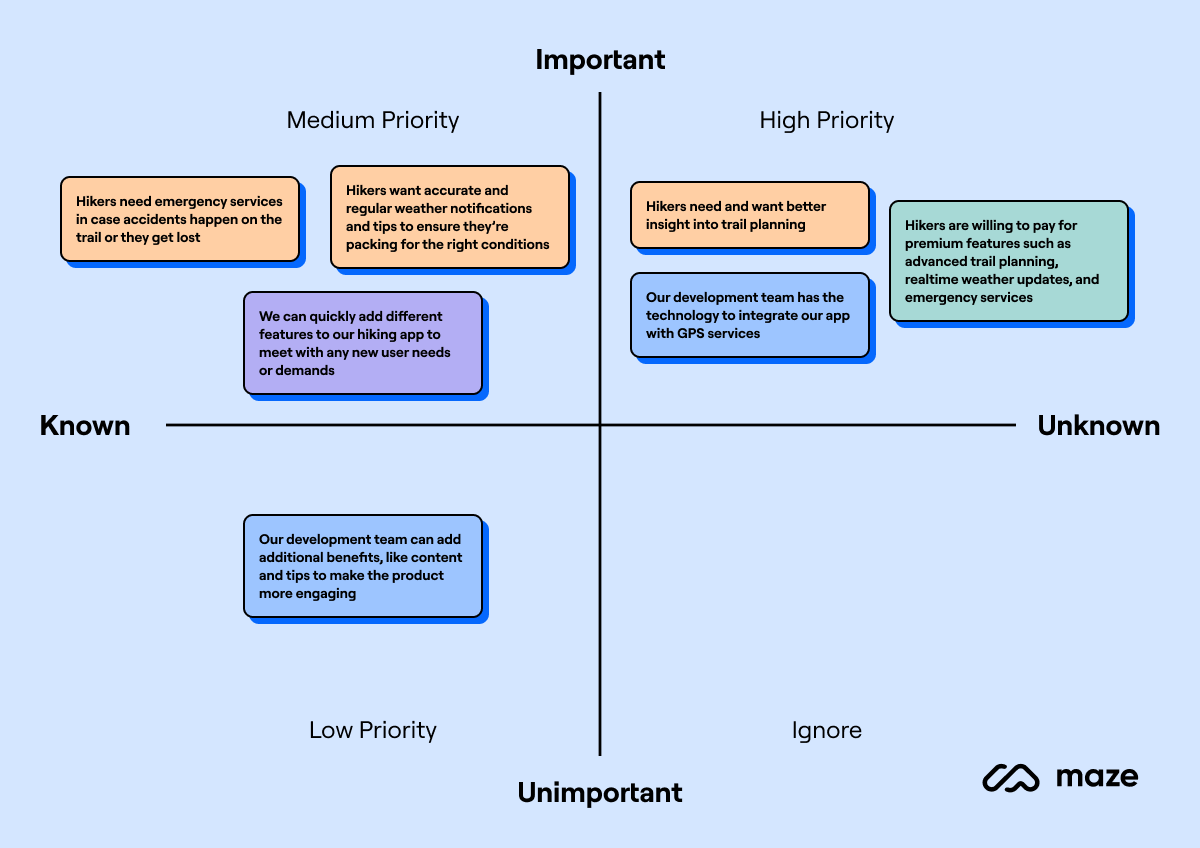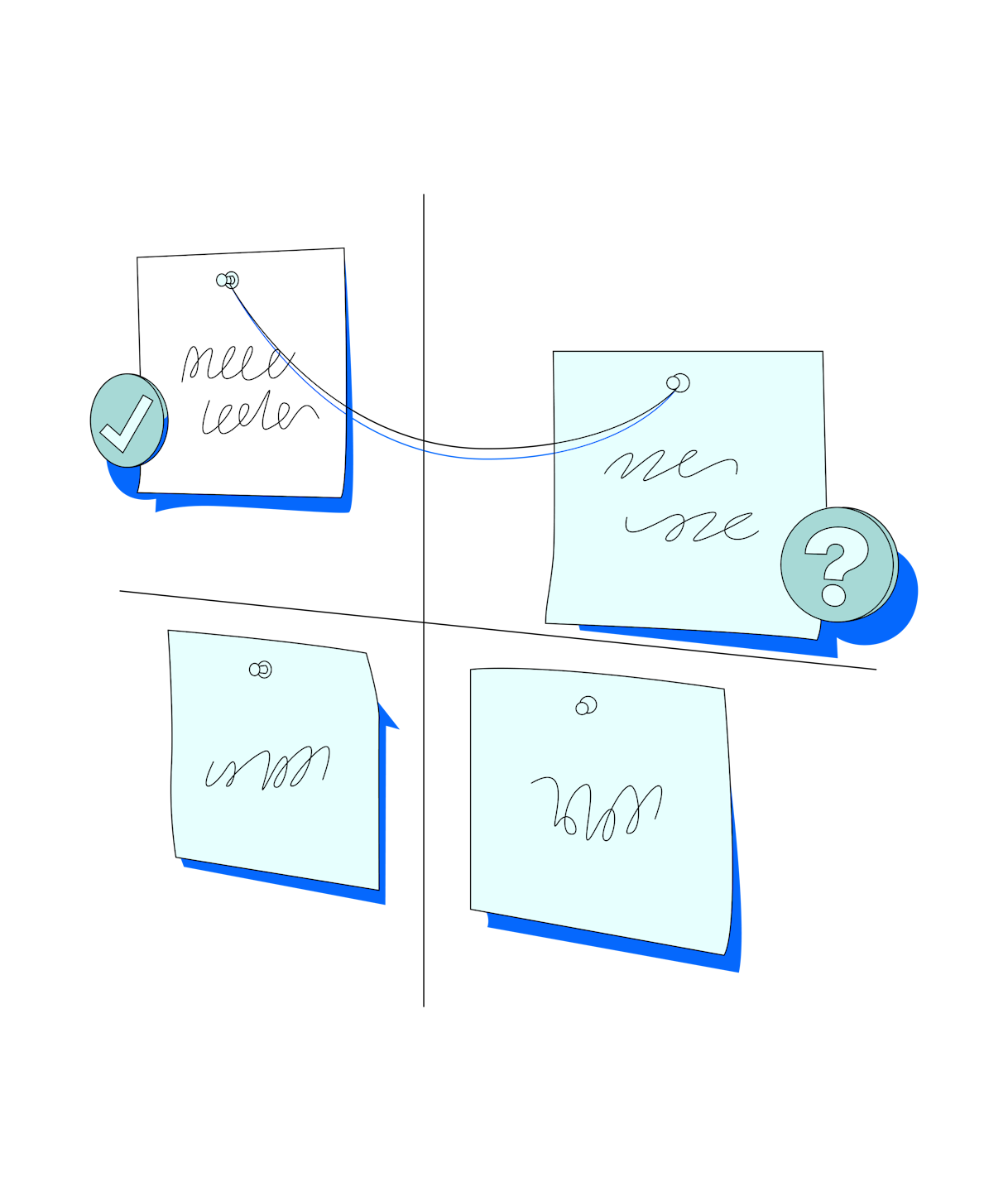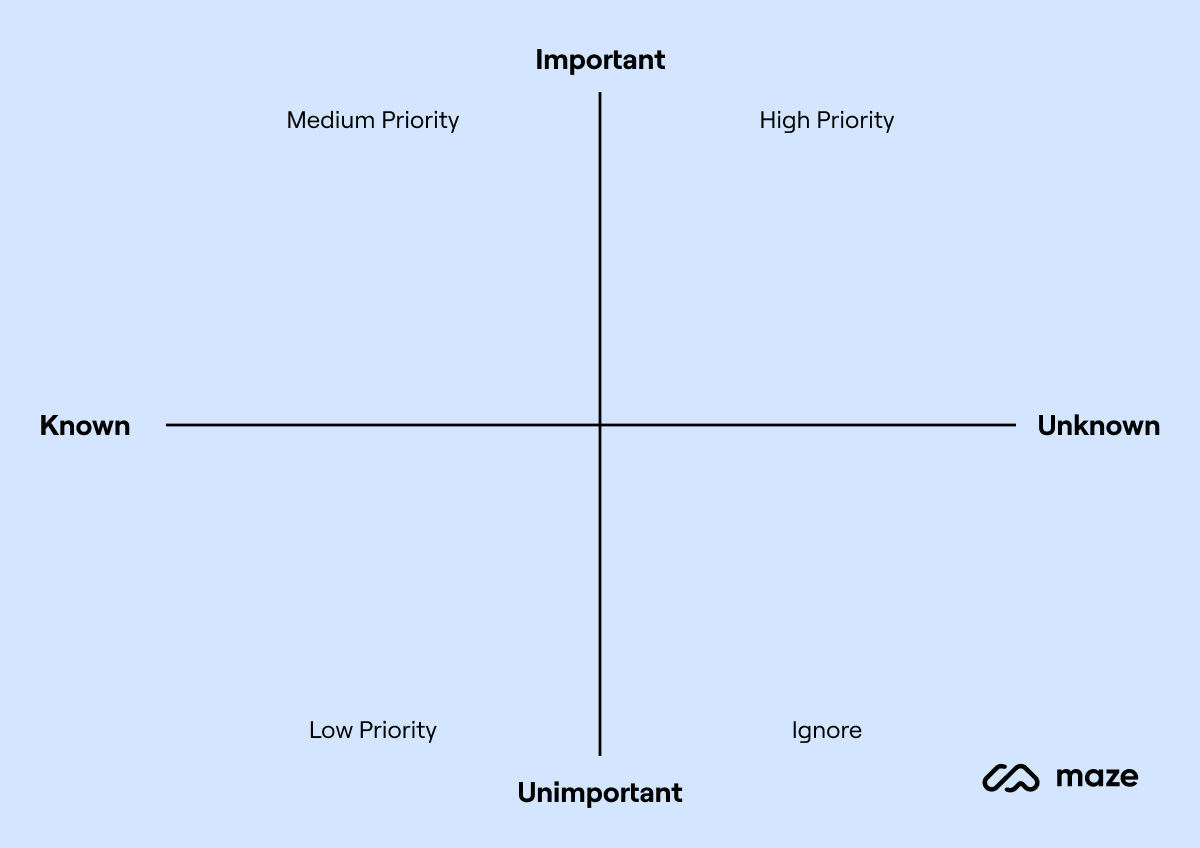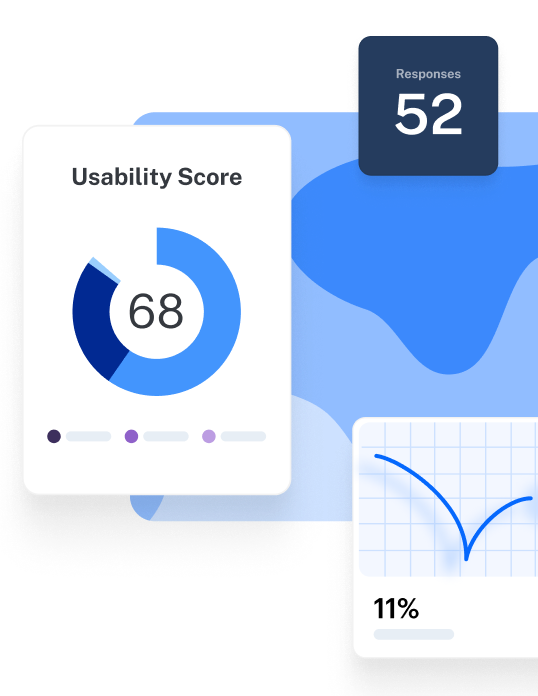Whenever a new idea is formed, it is inherently surrounded by assumptions. These may be assumptions about user preferences, the best way to build the product, or which feature will be its biggest success.
Assumptions are of course not automatically wrong—many of our assumptions come from data we’ve consumed or patterns we’ve seen. But nonetheless, they are assumptions, and need to be validated or disproved in order to move forward with accurate data and informed decisions.
That's where assumption mapping comes in.
Created by Lean UX co-authors Jeff Gothelf and Josh Seiden, this exercise helps you uncover and address the underlying, risky assumptions that drive many product decisions and jeopardize success.
By assessing assumptions early on, you can avoid costly mistakes that derail your development process, or even lead to product failure.
This article shows you how to identify, map, and test your assumptions through assumption mapping.
What is assumption mapping?
Assumption mapping is a strategic exercise that helps product development teams identify implicit beliefs about their product and users. It allows teams to analyze which of these beliefs pose potential risks, are unfounded, or require further testing.
As humans, we’re all subject to unconscious cognitive biases. These combined with individual beliefs and experiences can lead to different assumptions—ranging from positive expectations, to harmful prejudices. Regardless, they are biased, and can harm product development.
There are three main types of assumptions product teams can unpack with this exercise:
- Desirability assumptions: Whether users want or need the product—these focus on beliefs about user preferences and behaviors
- Feasibility assumptions: Whether the team has the adequate technology, skills, and resources to build the product
- Viability assumptions: Regarding the product’s ability to generate revenue, sustain itself in the market, and fulfill business objectives
💡 Sometimes organizations also include adaptability assumptions when mapping assumptions. These are beliefs about whether a product can quickly adapt to a changing environment, such as shifting user needs or market trends.
How does assumption mapping work?
Let’s say you have an idea for a platform that connects consumers directly to local farmers, allowing them to purchase fresh produce. Some of your assumptions might be as follows:
Desirability:
- Potential users would rather buy their produce directly from farmers
- Potential users care about their food’s freshness enough to use the platform
Feasibility: - We have the talent and resources necessary to build the platform successfully
- We have enough resources to invest in and establish a reliable logistics network to support the pickup and delivery of fresh produce
Viability: - There is sufficient market demand for fresh, locally sourced produce to meet profit targets and sustain the platform
- This market is scalable, allowing us to expand into different regions and include new food products
Next, you’ll color code these assumptions, place them on a matrix, and collaborate with your team to identify risky beliefs that can influence your product development process.
Where do we use assumption mapping in UX?
Assumption mapping is typically the most helpful for cross-team brainstorming at the problem discovery phase of product development. However, UX teams can also use this exercise at various points in the design process, such as:
- User research planning: Assumption mapping helps UX teams pinpoint which beliefs about user needs, expectations, and motivations are unfounded or require more research for validation
- Ideation phase: Assumption mapping acts as a strategic springboard for ideas, letting UX teams explore and prioritize a broad range of solutions from their original beliefs
- Testing phase: Assumption mapping helps UX teams understand which solutions need more testing with the help of user paths, wireframes, and prototypes
But just how important is this strategic exercise, and do you really need it in your product development process?
Why is assumption mapping important for product development?
Assumption mapping helps you assess whether your solution is desirable for your users, feasible for your team, and viable for your stakeholders. It also helps to manage risks, ease decision-making, and improve the chances of your product's success.
With assumption mapping, you can:
- Identify uncertainties: Clarifying assumptions gives your team a chance to address and prioritize implicit biases that could potentially jeopardize product success
- Create user-centered designs: Pinpointing which beliefs need further validation helps guide research and testing, leading to more insights and data-backed decisions
- Efficiently allocate resources: By validating and disproving beliefs early on, teams can avoid investing resources in developing products or features based on incorrect assumptions
Put simply: Investing in a design solution based on incorrect assumptions is a costly mistake for businesses. Assumption mapping is how you avoid it.
How to get started with assumptions mapping: identifying, mapping, and testing assumptions
Before you begin assumption mapping, consider these guidelines:
- Ensure the assumptions you’re making are grounded in information you already have, while being relevant to the context of your product
- You’ll need sticky notes for assumption mapping (if you’re not going digital for this exercise)—make sure to limit yourself to one statement per sticky note.
- Strong beliefs and assumptions are okay, but be sure to keep an open mind for new information that arises through the exercise
Got it? Great, here’s how your team can start assumption mapping and de-risk your product development process.
Identifying assumptions: Creating hypotheses to evaluate
Begin by writing down your assumptions on separate sticky notes in the form of research hypotheses.
These are specific statements that can be proven or disproven with the help of research and data.
Keep each hypothesis specific, yet short and precise for easier prioritization. We also suggest color-coding each assumption type with one color for desirability, another for feasibility, and another for viability. If you’re mapping adaptability, select a separate color for that assumption type, too.
Once you’ve written down all your assumptions, it’s time to start mapping them out.
Mapping assumptions: Identifying major blockers for success
Begin placing your sticky notes on an assumption matrix. This graph consists of four quadrants, each representing a level of importance and your knowledge of each assumption.
These four quadrants include:
- Important and unknown assumptions: You lack sufficient knowledge of these crucial assumptions. Focus on validating them through research and testing.
- Important and known assumptions: These are assumptions that are vital to your project and that you have enough knowledge about. Double-check, document, and monitor them as the project progresses to ensure they remain valid.
- Unimportant and unknown assumptions: These assumptions are not vital to your product’s success, nor do you know if they're true or not. Address them only if resources and time permit.
- Unimportant and known assumptions: These are assumptions with minimal impact on your project and are already well understood. They don’t require any action, but you can revisit them if necessary.
To gauge how important or unimportant an assumption is for product development success, consider the potential impact of it being false. Would being wrong in your assumption jeopardize the whole initiative, or would it only minimally affect your solution?
For assessing knowns and unknowns, read any available data. Assumptions supported by quantitative feedback belong in the known section, while qualitative evidence and anecdotes fall more in the middle. Hunches, gut feelings, and even expert-driven opinions belong in the unknown category.
Once you’ve mapped out your matrix, you’re ready to start validating your assumptions.
Testing assumptions: Rejecting and validating assumptions with user research
To validate your most important assumptions, you need to conduct user research, collect data, and use the insights to prove or disprove your beliefs.
Some methods to validate your assumptions are:
- User interviews and focus groups: Sitting down with your users and asking them questions helps you quickly identify their needs, expectations, and the motivations that drive them
- Live website and usability testing: Seeing how easily a user interacts with your product or feature lets you collect feedback for assumptions on meeting user requirements
- Surveys: Collect generalizable, statistical data on assumptions regarding user needs, expectations, and the market demand for your product
Need a quick and easy way to test your assumptions?
Maze’s suite of comprehensive UX research methods includes Interview Studies, User Surveys, and Live Website Testing to help you gain insight quickly.
An assumption mapping workshop: Example + template
Assumption mapping is a valuable tool for user experience teams—provided you complete the exercise correctly. Let's go through an example here—follow along with our assumption map template above.
Let’s say you’ve had an idea for an app that helps hikers find the best routes, access emergency support, and prepare for weather conditions. Together with your team, you begin writing assumptions on colored sticky notes.
When it comes to desirability, your team has three assumptions:
- Hikers need and want better insight into trail planning; it’s one of their biggest challenges
- Hikers need emergency support in case accidents happen on the trail or they get lost
- Hikers want accurate and regular weather notifications and tips to ensure they’re packing for the right conditions
In terms of feasibility, you have two assumptions:
- Our development team has the technology to integrate our app with GPS services
- Our development team can add additional benefits, like content and tips to make the product more engaging
For viability, you settle for a single assumption:
- Hikers are willing to pay for premium features such as advanced trail planning, real-time weather updates, and emergency services
Lastly, you have one adaptability assumption:
- We can add different features to our hiking app to meet new user needs or demands
Next, your team considers each assumption and how important it is to the success of your project, as well as how confident you are in its truth. You then map your assumptions on the matrix.

Let’s take a look at our most important and unknown category:
- Hikers want better insight into trail planning: Your product relies on this function as its main feature, but you’ll need to conduct UX research to confirm if it’s what users need.
- Hikers are willing to pay for premium features such as advanced trail planning, real-time weather updates, and emergency services: This assumption makes the value proposition and business case for developing your product. While you’ve had success designing hiking apps, you’re still unsure if these are the features hikers would pay a premium for.
- Our development team has the technology to integrate our app with GPS services: Your product’s main feature relies upon a robust GPS system, so you’ll need to thoroughly check if your development team is capable of creating the function.
Next, it’s time to validate assumptions.
You conduct a survey and user interviews to assess whether hikers want better insight into trail planning and are willing to pay for it.
The results confirm your assumptions. 94% of your respondents stated that trail planning is one of their biggest challenges, and 78% said they’d pay a premium to make it easier. Your interviewees go into detail about what makes the process so challenging—giving you insight into how you can build a product that solves issues currently faced by hikers.
Following this flow, you can take each unknown assumption and conduct UX research to validate or disprove it. Once everything is confirmed, you can record the results and move forward with your project in the knowledge that any assumptions you’re working with are true.
Validate and reject assumptions with user research
Assumption mapping paves the way for de-risking your entire product development and design process. It saves you from costly mistakes and wasted effort building a product that users don’t want—provided you test your assumptions correctly.
This is where Maze can help.
Maze is a leading user research platform that empowers businesses to uncover decision-driving user insights. Along with a comprehensive suite of moderated and unmoderated user research methods, Maze also supports user research with its participant recruitment solutions, Panel and Reach.
When you’re finished with your research project with Maze, you can generate insightful, digestible UX reports to share with project stakeholders.
Assumption mapping is just one step in the product development process; but validating your decisions with user insights is crucial at every stage of the process. Maze makes it easy to ensure you’re building with users, informed by their insights, every step of the way.
Frequently asked questions about assumption mapping
What is an assumption map?
What is an assumption map?
An assumption map is a visual tool product development teams use to identify, organize, and prioritize assumptions they have about the desirability, feasibility, viability, and adaptability of their product and its users. It helps teams systematically address uncertainties and validate critical assumptions that impact product success.
What are examples of desirability, feasibility, viability, and adaptability assumptions?
What are examples of desirability, feasibility, viability, and adaptability assumptions?
An example for each assumption are:
- Desirability: “Users want a new profile dashboard on our product”
- Feasibility: “The development team has sufficient skills and resources to implement a new profile dashboard feature into our product”
- Viability: “People will pay for a new, premium profile dashboard on our product”
- Adaptability: “We can adjust and change our new profile dashboard to meet any changes with user needs or expectations”







